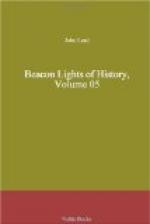This style of architecture prevailed till the twelfth century, and was seen in its greatest perfection in Germany under the Saxon emperors, especially in the Rhenish provinces, as in the cathedrals of Spires, Mentz, Worms, and Nuremberg. Its general effect was gloomy and heavy; a separation from the outward world,—a world disgraced by feudal wars and peasants’ wrongs and general ignorance, which made men sad, morose, inhuman. It flourished in ages when the poor had no redress, and were trodden under the feet of hard feudal masters; when there was no law but of brute force; when luxuries were few and comforts rare,—an age of hardship, privation, poverty, suffering; an age of isolations and sorrows, when men were forced to look beyond the grave for peace and hope, when immortality through a Redeemer was the highest inspiration of life. Everybody was agitated by fears. The clergy made use of this universal feeling by presenting the terrors of the law,—the penalty of sin,—everlasting physical burnings, from which the tortured soul could be extricated only by penance and self-expiation, offerings to the Church, and entire subserviency to the will of the priest, who held the keys of heaven and hell. The men who lived when the Romanesque churches dotted every part in Europe looked upon society and saw nothing but grief,—heavy burdens, injustices, oppressions, cruel wrongs; and they hid their faces and wept, and said: “Let us retreat from this miserable world which discord ravages; let us hide ourselves in contemplation; let us prepare to meet God in judgment; let us bring to Him our offering; let us propitiate Him; let us build Him a house, where we may chant our mournful songs.” So the church arises,—in Germany, in France, in England,—solemn, mystical, massive, a type of sorrow, in the form of a cross, with “a sepulchral crypt like the man in the tomb, before the lofty spire pointed to the man who had risen to Heaven.” The church is still struggling, and is not jubilant, except in Gregorian chants, and is not therefore lofty or ornamental. It is a vault. It is more like a catacomb than a basilica, for the world is buried deep in sorrows and fears. Look to any of the Saxon churches of the period when the Romanesque prevailed, and they are low, gloomy, and damp, though massive and solemn. The church as an edifice ever represents the Church as an institution or a power, ever typifies prevailing sentiments and ideas. Perhaps the finest of the old Romanesque churches was that of Cluny, in Burgundy, destroyed during the French Revolution. It had five aisles, and was five hundred and twenty feet in length. It had a stately tower at the intersection of the transepts, and six other towers. It was early Norman, and loftier than the Saxon churches, although heavy and massive like them.
But the Romanesque church, with all its varieties, is still gloomy, dark, sepulchral, reminding us of the sorrows of the Middle Ages, and the dreary character of prevailing religious sentiments,—fervent, sincere, profound, but sad,—the sentiments of an age of ignorance and faith.




